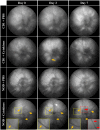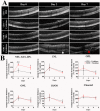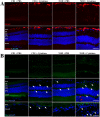Intravitreal pro-inflammatory cytokines in non-obese diabetic mice: Modelling signs of diabetic retinopathy
- PMID: 30133488
- PMCID: PMC6105000
- DOI: 10.1371/journal.pone.0202156
Intravitreal pro-inflammatory cytokines in non-obese diabetic mice: Modelling signs of diabetic retinopathy
Abstract
Diabetic retinopathy is a vascular disease of the retina characterised by hyperglycaemic and inflammatory processes. Most animal models of diabetic retinopathy are hyperglycaemia-only models that do not account for the significant role that inflammation plays in the development of the disease. In the present study, we present data on the establishment of a new animal model of diabetic retinopathy that incorporates both hyperglycaemia and inflammation. We hypothesized that inflammation may trigger and worsen the development of diabetic retinopathy in a hyperglycaemic environment. Pro-inflammatory cytokines, IL-1β and TNF-α, were therefore injected into the vitreous of non-obese diabetic (NOD) mice. CD1 mice were used as same genetic background controls. Fundus and optical coherence tomography images were obtained before (day 0) as well as on days 2 and 7 after intravitreal cytokine injection to assess vessel dilation and beading, retinal and vitreous hyper-reflective foci and retinal thickness. Astrogliosis and microgliosis were assessed using immunohistochemistry. Results showed that intravitreal cytokines induced vessel dilation, beading, severe vitreous hyper-reflective foci, retinal oedema, increased astrogliosis and microglia upregulation in diabetic NOD mice. Intravitreal injection of inflammatory cytokines into the eyes of diabetic mice therefore appears to provide a new model of diabetic retinopathy that could be used for the study of disease progression and treatment strategies.
Conflict of interest statement
We, the authors declare that no competing interests exist.
Figures









Similar articles
-
Connexin43 hemichannel block protects against the development of diabetic retinopathy signs in a mouse model of the disease.J Mol Med (Berl). 2019 Feb;97(2):215-229. doi: 10.1007/s00109-018-1727-5. Epub 2018 Dec 8. J Mol Med (Berl). 2019. PMID: 30535867
-
Effects of intravitreal injection of human CD34+ bone marrow stem cells in a murine model of diabetic retinopathy.Exp Eye Res. 2020 Jan;190:107865. doi: 10.1016/j.exer.2019.107865. Epub 2019 Nov 1. Exp Eye Res. 2020. PMID: 31682846 Free PMC article.
-
BTBR ob/ob mouse model of type 2 diabetes exhibits early loss of retinal function and retinal inflammation followed by late vascular changes.Diabetologia. 2018 Nov;61(11):2422-2432. doi: 10.1007/s00125-018-4696-x. Epub 2018 Aug 9. Diabetologia. 2018. PMID: 30094465 Free PMC article.
-
Practical Lessons from Protocol I for the Management of Diabetic Macular Edema.Dev Ophthalmol. 2017;60:91-108. doi: 10.1159/000459692. Epub 2017 Apr 20. Dev Ophthalmol. 2017. PMID: 28427069 Review.
-
Local and Systemic Inflammatory Biomarkers of Diabetic Retinopathy: An Integrative Approach.Invest Ophthalmol Vis Sci. 2017 May 1;58(6):BIO68-BIO75. doi: 10.1167/iovs.17-21769. Invest Ophthalmol Vis Sci. 2017. PMID: 28510630 Review.
Cited by
-
Retinal Vascular Endothelial Cell Dysfunction and Neuroretinal Degeneration in Diabetic Patients.J Clin Med. 2021 Jan 25;10(3):458. doi: 10.3390/jcm10030458. J Clin Med. 2021. PMID: 33504108 Free PMC article. Review.
-
Cytokine interplay among the diseased retina, inflammatory cells and mesenchymal stem cells - a clue to stem cell-based therapy.World J Stem Cells. 2019 Nov 26;11(11):957-967. doi: 10.4252/wjsc.v11.i11.957. World J Stem Cells. 2019. PMID: 31768222 Free PMC article. Review.
-
Comprehensive Grading System for Experimental Autoimmune Uveitis in Mice.Biomedicines. 2023 Jul 18;11(7):2022. doi: 10.3390/biomedicines11072022. Biomedicines. 2023. PMID: 37509662 Free PMC article.
-
Connexin43 hemichannel block protects against the development of diabetic retinopathy signs in a mouse model of the disease.J Mol Med (Berl). 2019 Feb;97(2):215-229. doi: 10.1007/s00109-018-1727-5. Epub 2018 Dec 8. J Mol Med (Berl). 2019. PMID: 30535867
-
Rodent Models of Diabetic Retinopathy as a Useful Research Tool to Study Neurovascular Cross-Talk.Biology (Basel). 2023 Feb 7;12(2):262. doi: 10.3390/biology12020262. Biology (Basel). 2023. PMID: 36829539 Free PMC article. Review.
References
Publication types
MeSH terms
Substances
LinkOut - more resources
Full Text Sources
Other Literature Sources
Medical
Molecular Biology Databases

